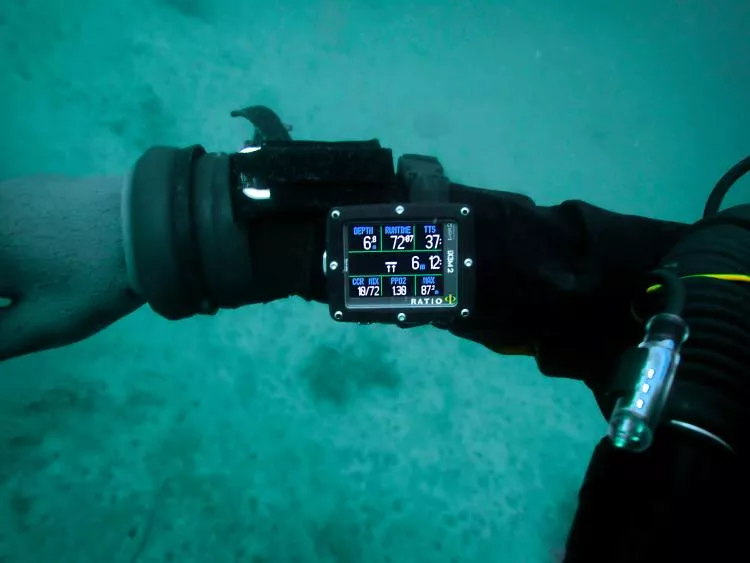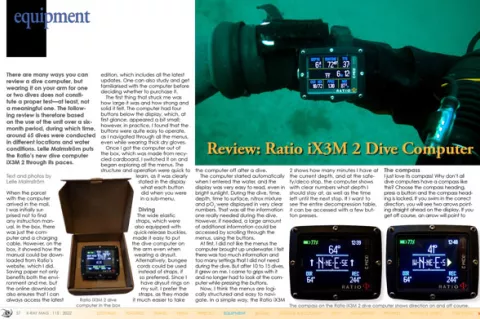There are many ways you can review a dive computer, but wearing it on your arm for one or two dives does not constitute a proper test—at least, not a meaningful one. This review is therefore based on the use of the unit over a six-month period, where around 65 dives were conducted in different locations and water conditions. Lelle Malmström puts the Ratio’s new dive computer iX3M 2 through its paces.
Contributed by
Factfile
RATIO iX3M 2 DIVE COMPUTER
Display
Colour, IPS, 2.8-inch, 320x240 pixel, 144 dpi, 100% matrix
Wireless Air Integration (Transmitter, Sender)
Compatible with Ratio Colour Coded Wireless Transmitter
Multi Transmitter
Up to 10 wireless transmitters
Mix
10 mix (+ 3 diluents) (O2: 05% - 99% / He: 0% - 95%)
Deco model (Algorithm)
Buhlmann ZHL-12 + Buhlmann ZHL-16 B + Buhlmann ZHL-16 C + VPM-B
Algorithm adjustment
User settable Gradient Factors (GFL/GFH) for Buhlmann and user-settable Bubble Radius for VPM
Water type
Salt water / fresh water / EN13319
Deep Stop
Standard method + Pyle method
Alerts
Vibration + acoustic + visual
Dive Planner
No Deco Limit + Full Deco Planner
Compass
3D Compass, 1° resolution, +/- 1° accuracy
Battery
USB rechargeable Li-ion (~20 hours of diving)
Weight
220gr / 7.7oz
Logbook
~160 hours of scuba (sampling 10 seconds)
Max Depth
220m / 721ft
When the parcel with the computer arrived in the mail, I was initially surprised not to find any instruction manual. In the box, there was just the computer and a charging cable. However, on the box, it showed how the manual could be downloaded from Ratio’s website, which I did. Saving paper not only benefits both the environment and me, but the online download also ensures that I can always access the latest edition, which includes all the latest updates. One can also study and get familiarised with the computer before deciding whether to purchase it.
The first thing that struck me was how large it was and how strong and solid it felt. The computer had four buttons below the display, which, at first glance, appeared a bit small; however, in practice, I found that the buttons were quite easy to operate, as I navigated through all the menus, even while wearing thick dry gloves.
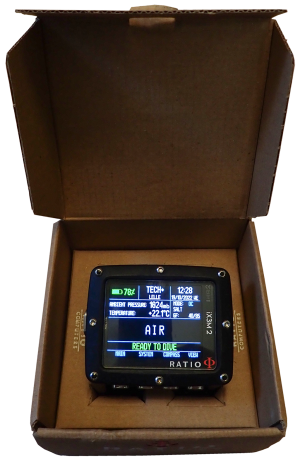
Photo by Lelle Malmström
Once I got the computer out of the box, which was made from recycled cardboard, I switched it on and began exploring all the menus. The structure and operation were quick to learn, as it was clearly stated in the display what each button did when you were in a sub-menu.
Diving
The wide elastic straps, which were also equipped with quick-release buckles, made it easy to put the dive computer on the arm even when wearing a drysuit. Alternatively, bungee cords could be used instead of straps, if so preferred. Since I have drysuit rings on my suit, I prefer the straps, as they made it much easier to take the computer off after a dive.
The computer started automatically when I entered the water, and the display was very easy to read, even in bright sunlight. During the dive, time, depth, time to surface, nitrox mixture and pO2 were displayed in very clear numbers. That was all the information one really needed during the dive. However, if needed, a large amount of additional information could be accessed by scrolling through the menus, using the buttons.
At first, I did not like the menus the computer brought up underwater. I felt there was too much information and too many settings that I did not need during the dive. But after 10 to 15 dives, it grew on me. I came to grips with it and no longer had to look at the computer while pressing the buttons.
Now, I think the menus are logically structured and easy to navigate. In a simple way, the Ratio iX3M 2 shows how many minutes I have at the current depth, and at the safety/deco stop, the computer shows with clear numbers what depth I should stay at, as well as the time left until the next stop. If I want to see the entire decompression table, it can be accessed with a few button presses.
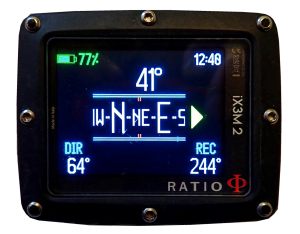
The compass
I just love its compass! Why don’t all dive computers have a compass like this? Choose the compass heading, press a button and the compass heading is locked. If you swim in the correct direction, you will see two arrows pointing straight ahead on the display. If you get off course, an arrow will point to the right or left, indicating the direction to take to get back on the right course. It could not be simpler.
Many new functions
The Ratio iX3M 2 comes with many features that you probably did not know you wanted or needed. It can connect to up to ten wireless transmitters to obtain tank pressure, and if you dive sidemount, the computer will automatically switch to display information about the tank from which you are breathing.
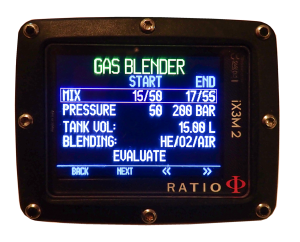
Another function, which I find superb, is a simple gas blender programme, which lets you see what kind of mix you end up with in the tank if, for example, you top it up with air after a dive. Once you know the mix by using the gas blender programme, it is easy to use the built-in deco table to provide times for the next dive.
Furthermore, with an accessory that connects to the computer via cable, the diver can analyse which nitrox mixture is in the tank; the measurement is then simply saved to the computer with the push of a button. Visit Ratio’s website (ratio-computers.com) for loads of videos on many of the functions and explanations of how to use the iX3M 2.
The dive log
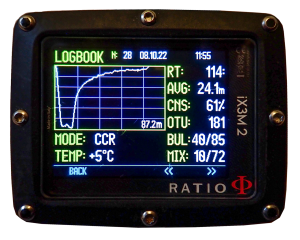
The logged dives are easily reviewed on the computer’s large display and transferred to a desktop computer or laptop. Ratio uses a logging program called Subsurface (subsurface-divelog.org). The software is open source and free to download and use. The programme supports most computers on the market, so you do not need to have your logs in several different programmes when you have upgraded to an iX3M 2, and it is fine to import entire backup files into the programme.
Updating the software
Updating iX3M 2 is quite easy. Download the ToolBox programme from Ratio’s website, start the programme, press “Upgrade,” wait a while… and hey, presto! It sounds simple enough, but I initially had a bit of trouble using it with my Mac computer. However, instructions are given on the same website, and after following them, I soon had the programme up and running.
Summary
Do you need such an advanced dive computer? That is not a simple or easy question to answer. But my response would be YES! The iX3M 2 not only has all the features that I currently need, but I will never “outgrow” this computer either. The iX3M 2 suits all divers from beginners to technical divers.

Yes, it is a big computer, and not one you would wear at a bar to show off that you are a diver. However, its large and clear display makes the information easy to read, even if you are older and feel that the numbers on your little watch computer are getting hard to read.
The manufacturer states that a fully charged battery lasts approximately 20 dive hours. In any case, I never worried about the battery not having enough juice, as the dive computer automatically charges when it is connected to a desktop or laptop computer as you download the dives to the log programme. Most USB chargers can also be used, but I found that my iPad charger charged the iX3M 2 the fastest.
Are there any features I feel are missing? Not really. But I would like to suggest perhaps adding some games, which can keep me entertained during long decompression stops. Hopefully, the manufacturer will consider including one in a future update.

